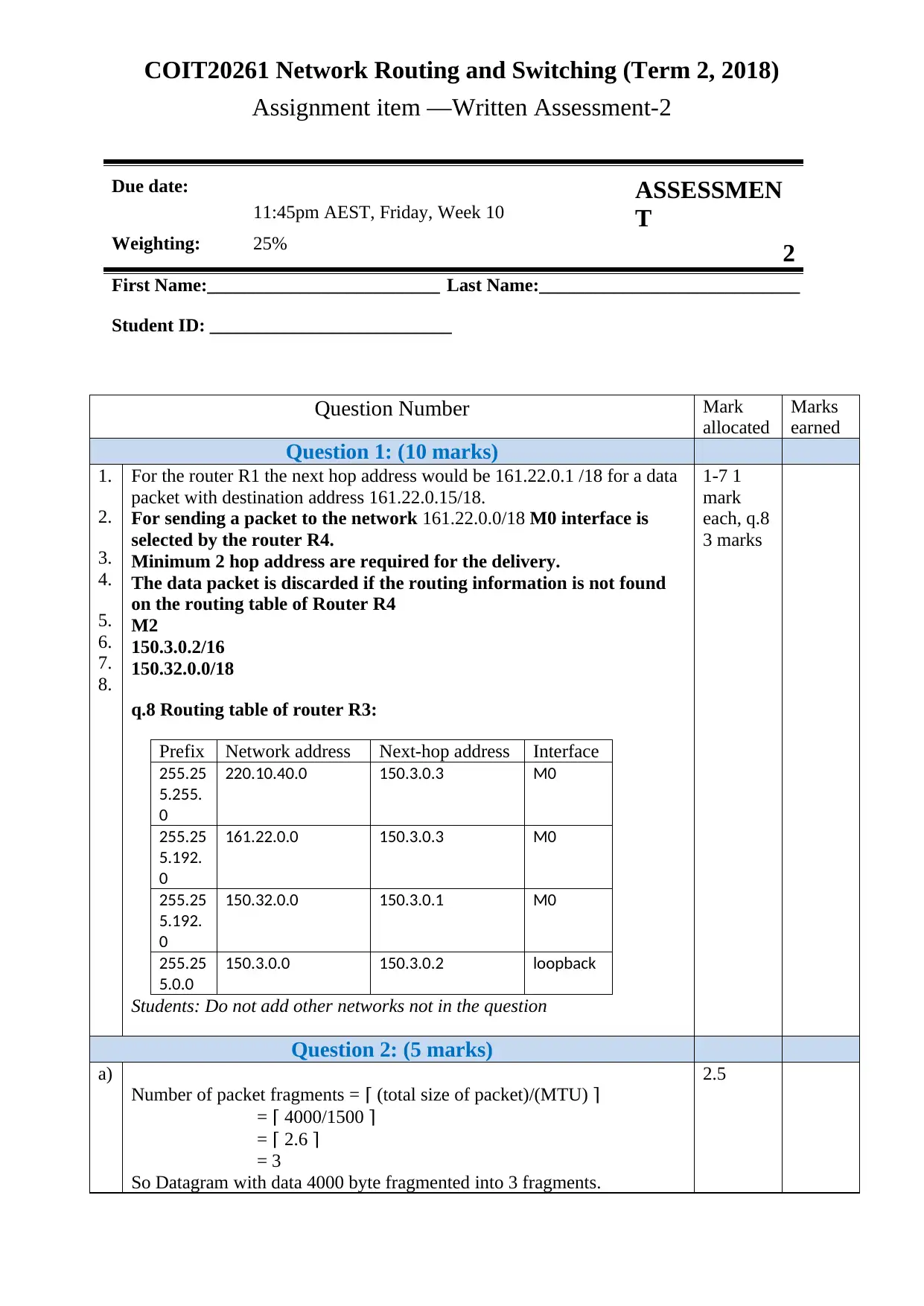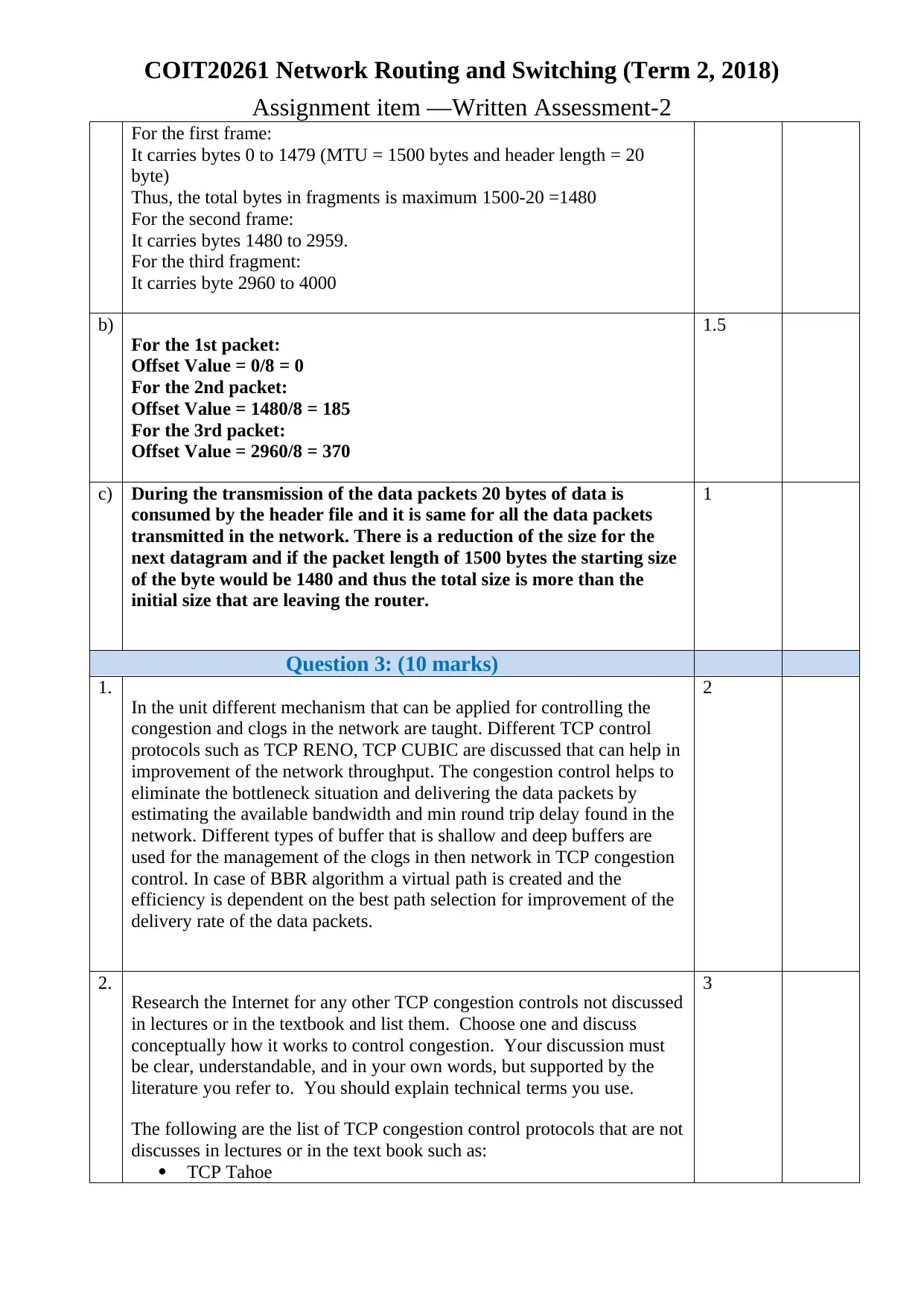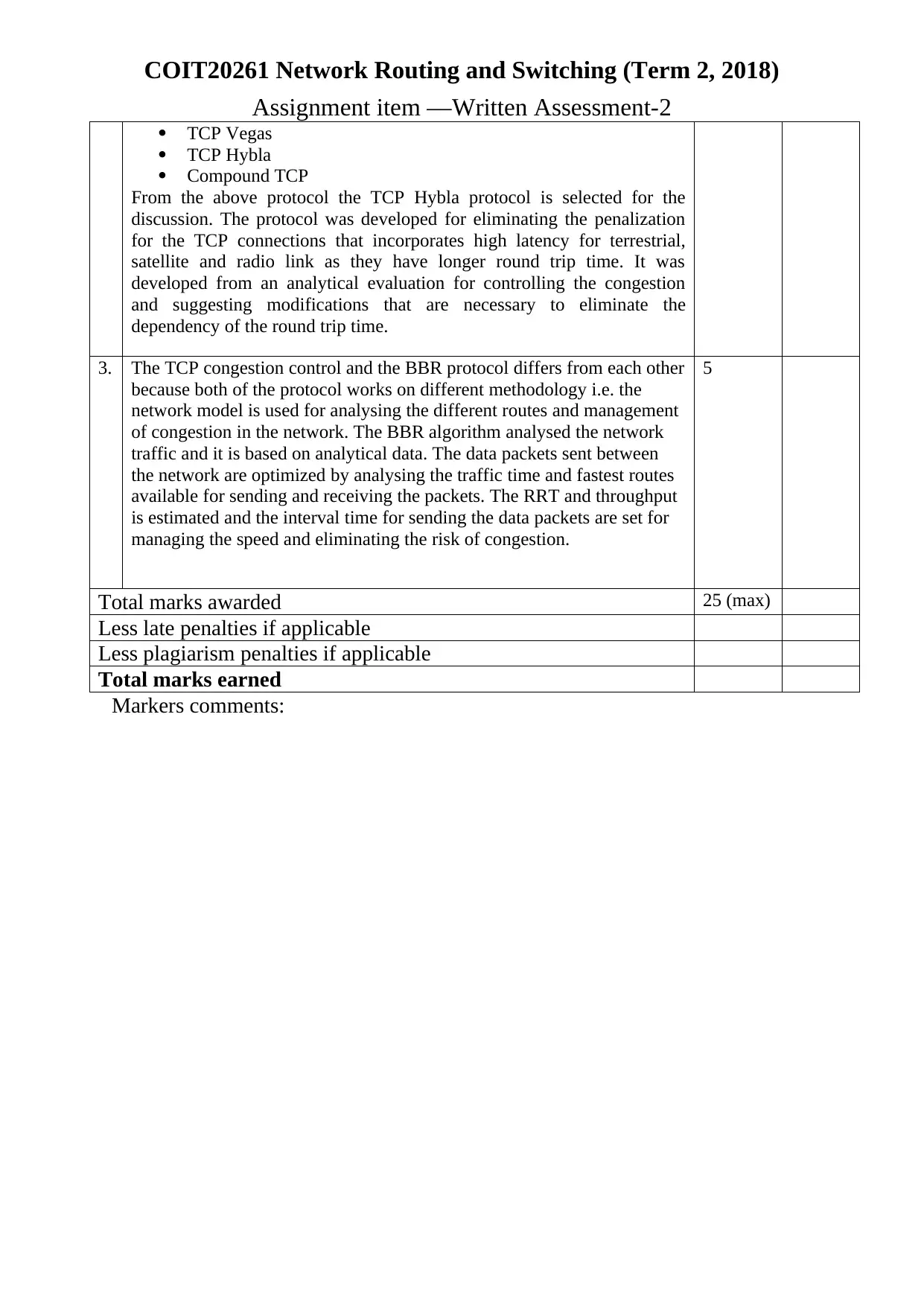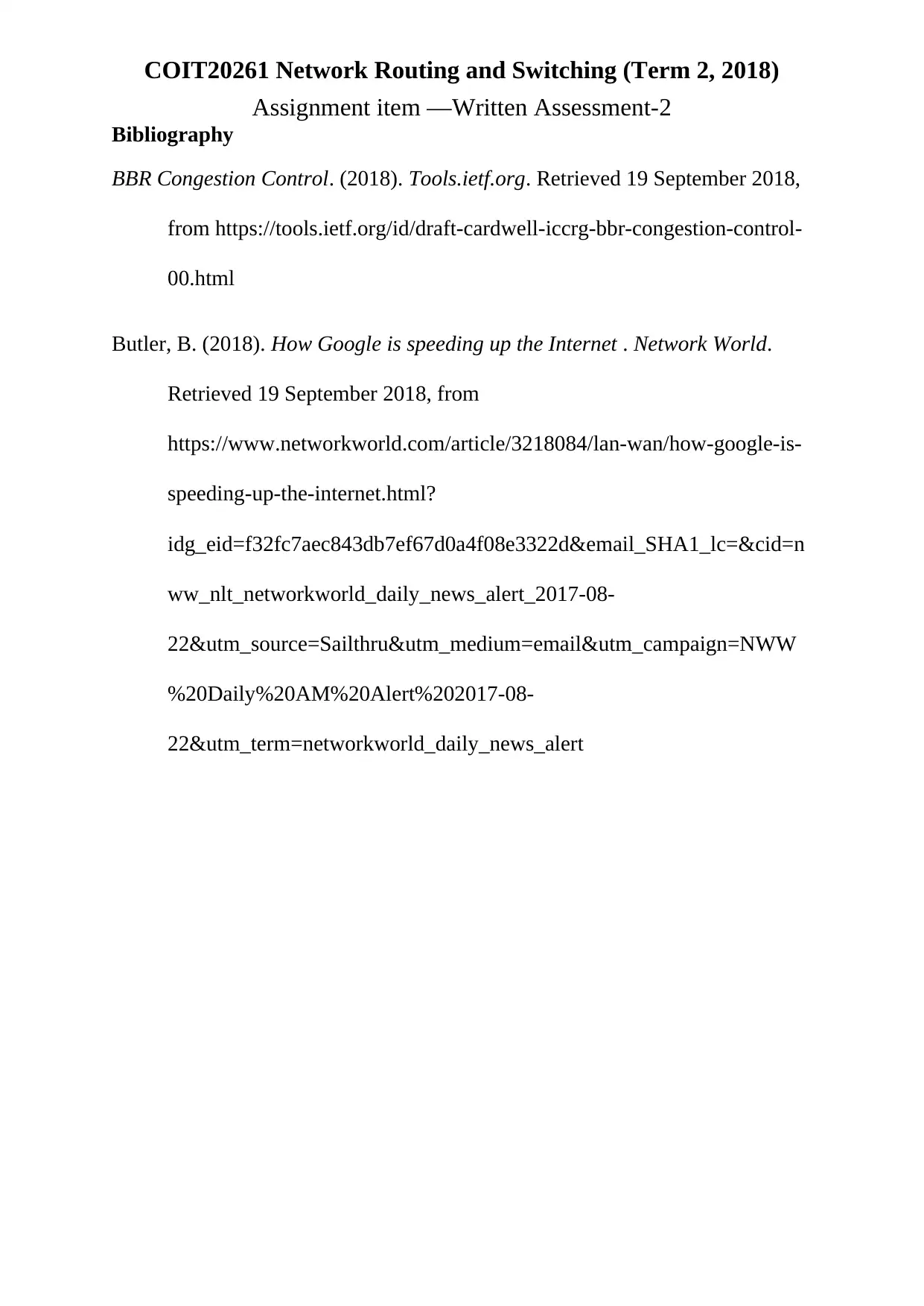Network Routing and Switching: COIT20261 Written Assessment, Term 2
VerifiedAdded on 2023/06/05
|4
|986
|200
Homework Assignment
AI Summary
This document presents a completed written assessment for the COIT20261 Network Routing and Switching course, Term 2, 2018. The assignment covers three main questions. Question 1 focuses on routing table analysis, including next-hop address determination and interface selection based on d...

COIT20261 Network Routing and Switching (Term 2, 2018)
Assignment item —Written Assessment-2
Due date:
11:45pm AEST, Friday, Week 10
ASSESSMEN
T
Weighting: 25% 2
First Name:_________________________ Last Name:____________________________
Student ID: __________________________
Question Number Mark
allocated
Marks
earned
Question 1: (10 marks)
1.
2.
3.
4.
5.
6.
7.
8.
For the router R1 the next hop address would be 161.22.0.1 /18 for a data
packet with destination address 161.22.0.15/18.
For sending a packet to the network 161.22.0.0/18 M0 interface is
selected by the router R4.
Minimum 2 hop address are required for the delivery.
The data packet is discarded if the routing information is not found
on the routing table of Router R4
M2
150.3.0.2/16
150.32.0.0/18
q.8 Routing table of router R3:
Prefix Network address Next-hop address Interface
255.25
5.255.
0
220.10.40.0 150.3.0.3 M0
255.25
5.192.
0
161.22.0.0 150.3.0.3 M0
255.25
5.192.
0
150.32.0.0 150.3.0.1 M0
255.25
5.0.0
150.3.0.0 150.3.0.2 loopback
Students: Do not add other networks not in the question
1-7 1
mark
each, q.8
3 marks
Question 2: (5 marks)
a)
Number of packet fragments = ⌈ (total size of packet)/(MTU) ⌉
= ⌈ 4000/1500 ⌉
= ⌈ 2.6 ⌉
= 3
So Datagram with data 4000 byte fragmented into 3 fragments.
2.5
Assignment item —Written Assessment-2
Due date:
11:45pm AEST, Friday, Week 10
ASSESSMEN
T
Weighting: 25% 2
First Name:_________________________ Last Name:____________________________
Student ID: __________________________
Question Number Mark
allocated
Marks
earned
Question 1: (10 marks)
1.
2.
3.
4.
5.
6.
7.
8.
For the router R1 the next hop address would be 161.22.0.1 /18 for a data
packet with destination address 161.22.0.15/18.
For sending a packet to the network 161.22.0.0/18 M0 interface is
selected by the router R4.
Minimum 2 hop address are required for the delivery.
The data packet is discarded if the routing information is not found
on the routing table of Router R4
M2
150.3.0.2/16
150.32.0.0/18
q.8 Routing table of router R3:
Prefix Network address Next-hop address Interface
255.25
5.255.
0
220.10.40.0 150.3.0.3 M0
255.25
5.192.
0
161.22.0.0 150.3.0.3 M0
255.25
5.192.
0
150.32.0.0 150.3.0.1 M0
255.25
5.0.0
150.3.0.0 150.3.0.2 loopback
Students: Do not add other networks not in the question
1-7 1
mark
each, q.8
3 marks
Question 2: (5 marks)
a)
Number of packet fragments = ⌈ (total size of packet)/(MTU) ⌉
= ⌈ 4000/1500 ⌉
= ⌈ 2.6 ⌉
= 3
So Datagram with data 4000 byte fragmented into 3 fragments.
2.5
Paraphrase This Document
Need a fresh take? Get an instant paraphrase of this document with our AI Paraphraser

COIT20261 Network Routing and Switching (Term 2, 2018)
Assignment item —Written Assessment-2
For the first frame:
It carries bytes 0 to 1479 (MTU = 1500 bytes and header length = 20
byte)
Thus, the total bytes in fragments is maximum 1500-20 =1480
For the second frame:
It carries bytes 1480 to 2959.
For the third fragment:
It carries byte 2960 to 4000
b)
For the 1st packet:
Offset Value = 0/8 = 0
For the 2nd packet:
Offset Value = 1480/8 = 185
For the 3rd packet:
Offset Value = 2960/8 = 370
1.5
c) During the transmission of the data packets 20 bytes of data is
consumed by the header file and it is same for all the data packets
transmitted in the network. There is a reduction of the size for the
next datagram and if the packet length of 1500 bytes the starting size
of the byte would be 1480 and thus the total size is more than the
initial size that are leaving the router.
1
Question 3: (10 marks)
1.
In the unit different mechanism that can be applied for controlling the
congestion and clogs in the network are taught. Different TCP control
protocols such as TCP RENO, TCP CUBIC are discussed that can help in
improvement of the network throughput. The congestion control helps to
eliminate the bottleneck situation and delivering the data packets by
estimating the available bandwidth and min round trip delay found in the
network. Different types of buffer that is shallow and deep buffers are
used for the management of the clogs in then network in TCP congestion
control. In case of BBR algorithm a virtual path is created and the
efficiency is dependent on the best path selection for improvement of the
delivery rate of the data packets.
2
2.
Research the Internet for any other TCP congestion controls not discussed
in lectures or in the textbook and list them. Choose one and discuss
conceptually how it works to control congestion. Your discussion must
be clear, understandable, and in your own words, but supported by the
literature you refer to. You should explain technical terms you use.
The following are the list of TCP congestion control protocols that are not
discusses in lectures or in the text book such as:
TCP Tahoe
3
Assignment item —Written Assessment-2
For the first frame:
It carries bytes 0 to 1479 (MTU = 1500 bytes and header length = 20
byte)
Thus, the total bytes in fragments is maximum 1500-20 =1480
For the second frame:
It carries bytes 1480 to 2959.
For the third fragment:
It carries byte 2960 to 4000
b)
For the 1st packet:
Offset Value = 0/8 = 0
For the 2nd packet:
Offset Value = 1480/8 = 185
For the 3rd packet:
Offset Value = 2960/8 = 370
1.5
c) During the transmission of the data packets 20 bytes of data is
consumed by the header file and it is same for all the data packets
transmitted in the network. There is a reduction of the size for the
next datagram and if the packet length of 1500 bytes the starting size
of the byte would be 1480 and thus the total size is more than the
initial size that are leaving the router.
1
Question 3: (10 marks)
1.
In the unit different mechanism that can be applied for controlling the
congestion and clogs in the network are taught. Different TCP control
protocols such as TCP RENO, TCP CUBIC are discussed that can help in
improvement of the network throughput. The congestion control helps to
eliminate the bottleneck situation and delivering the data packets by
estimating the available bandwidth and min round trip delay found in the
network. Different types of buffer that is shallow and deep buffers are
used for the management of the clogs in then network in TCP congestion
control. In case of BBR algorithm a virtual path is created and the
efficiency is dependent on the best path selection for improvement of the
delivery rate of the data packets.
2
2.
Research the Internet for any other TCP congestion controls not discussed
in lectures or in the textbook and list them. Choose one and discuss
conceptually how it works to control congestion. Your discussion must
be clear, understandable, and in your own words, but supported by the
literature you refer to. You should explain technical terms you use.
The following are the list of TCP congestion control protocols that are not
discusses in lectures or in the text book such as:
TCP Tahoe
3

COIT20261 Network Routing and Switching (Term 2, 2018)
Assignment item —Written Assessment-2
TCP Vegas
TCP Hybla
Compound TCP
From the above protocol the TCP Hybla protocol is selected for the
discussion. The protocol was developed for eliminating the penalization
for the TCP connections that incorporates high latency for terrestrial,
satellite and radio link as they have longer round trip time. It was
developed from an analytical evaluation for controlling the congestion
and suggesting modifications that are necessary to eliminate the
dependency of the round trip time.
3. The TCP congestion control and the BBR protocol differs from each other
because both of the protocol works on different methodology i.e. the
network model is used for analysing the different routes and management
of congestion in the network. The BBR algorithm analysed the network
traffic and it is based on analytical data. The data packets sent between
the network are optimized by analysing the traffic time and fastest routes
available for sending and receiving the packets. The RRT and throughput
is estimated and the interval time for sending the data packets are set for
managing the speed and eliminating the risk of congestion.
5
Total marks awarded 25 (max)
Less late penalties if applicable
Less plagiarism penalties if applicable
Total marks earned
Markers comments:
Assignment item —Written Assessment-2
TCP Vegas
TCP Hybla
Compound TCP
From the above protocol the TCP Hybla protocol is selected for the
discussion. The protocol was developed for eliminating the penalization
for the TCP connections that incorporates high latency for terrestrial,
satellite and radio link as they have longer round trip time. It was
developed from an analytical evaluation for controlling the congestion
and suggesting modifications that are necessary to eliminate the
dependency of the round trip time.
3. The TCP congestion control and the BBR protocol differs from each other
because both of the protocol works on different methodology i.e. the
network model is used for analysing the different routes and management
of congestion in the network. The BBR algorithm analysed the network
traffic and it is based on analytical data. The data packets sent between
the network are optimized by analysing the traffic time and fastest routes
available for sending and receiving the packets. The RRT and throughput
is estimated and the interval time for sending the data packets are set for
managing the speed and eliminating the risk of congestion.
5
Total marks awarded 25 (max)
Less late penalties if applicable
Less plagiarism penalties if applicable
Total marks earned
Markers comments:
⊘ This is a preview!⊘
Do you want full access?
Subscribe today to unlock all pages.

Trusted by 1+ million students worldwide

COIT20261 Network Routing and Switching (Term 2, 2018)
Assignment item —Written Assessment-2
Bibliography
BBR Congestion Control. (2018). Tools.ietf.org. Retrieved 19 September 2018,
from https://tools.ietf.org/id/draft-cardwell-iccrg-bbr-congestion-control-
00.html
Butler, B. (2018). How Google is speeding up the Internet . Network World.
Retrieved 19 September 2018, from
https://www.networkworld.com/article/3218084/lan-wan/how-google-is-
speeding-up-the-internet.html?
idg_eid=f32fc7aec843db7ef67d0a4f08e3322d&email_SHA1_lc=&cid=n
ww_nlt_networkworld_daily_news_alert_2017-08-
22&utm_source=Sailthru&utm_medium=email&utm_campaign=NWW
%20Daily%20AM%20Alert%202017-08-
22&utm_term=networkworld_daily_news_alert
Assignment item —Written Assessment-2
Bibliography
BBR Congestion Control. (2018). Tools.ietf.org. Retrieved 19 September 2018,
from https://tools.ietf.org/id/draft-cardwell-iccrg-bbr-congestion-control-
00.html
Butler, B. (2018). How Google is speeding up the Internet . Network World.
Retrieved 19 September 2018, from
https://www.networkworld.com/article/3218084/lan-wan/how-google-is-
speeding-up-the-internet.html?
idg_eid=f32fc7aec843db7ef67d0a4f08e3322d&email_SHA1_lc=&cid=n
ww_nlt_networkworld_daily_news_alert_2017-08-
22&utm_source=Sailthru&utm_medium=email&utm_campaign=NWW
%20Daily%20AM%20Alert%202017-08-
22&utm_term=networkworld_daily_news_alert
1 out of 4
Related Documents
Your All-in-One AI-Powered Toolkit for Academic Success.
+13062052269
info@desklib.com
Available 24*7 on WhatsApp / Email
![[object Object]](/_next/static/media/star-bottom.7253800d.svg)
Unlock your academic potential
© 2024 | Zucol Services PVT LTD | All rights reserved.





